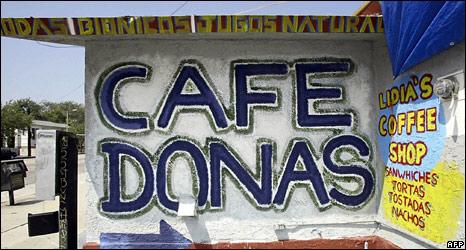Life in Spanglish for California's young Latinos
- Published

Donuts (donas), tortas, tostadas and nachos - at Lidia's coffee shop
Spanish can be heard on the streets of almost any major American city these days, as Hispanic immigrants mingle with the English-speaking majority.
But an increasing number, particularly children who've been through US schools, are bilingual. Very often they switch between languages within a single sentence, or borrow English words and put them into Spanish, making a hybrid known as Spanglish.
This group is now too big for media organisations and advertisers to ignore. New ways of broadcasting and marketing products are being developed to target them.
"I talk Spanish at home, except with my brothers, with them I speak English," says Adriana, a teenager at Bell High School in East Los Angeles, California.
"I listen to rock, but my dad is into the more traditional Mexican rancheras."
Like Adriana, many second generation Hispanics constantly navigate between two worlds and two languages: the English in which they learn at school and socialise, and the Spanish they speak at home with their parents.
Four out of five second-generation immigrant children speak English fluently, but the same proportion are also fluent in Spanish. Seven out of 10 confess to using Spanglish.
"Por ejemplo, I'm talking with my friends and sometimes Spanish gets mixed in with the English and you're like, hey, como estas, I saw you the other dayвҖҰ" says Ilyn, a 15-year-old, explaining how it works.
If you hear someone talking about "going out to hanguear (hang out) at the mol (mall)", that's Spanglish. So is "emailear", "sexapil" and "hora de lonche" (lunch hour).
Some sentences may be entirely in English, apart from one phrase in Spanish - or completely in Spanish, with the English connector "so" in the middle.
"I would describe it as a combination of two great languages to create a new expression that is richer than just speaking English or Spanish," says Cristina Burgos, who last year decided to write a blog in Spanglish.
"It's a code, because if you speak Spanglish you know that someone is bilingual and that you can communicate with them on a deeper level because you share biculturalism. It also helps to describe things in more detail," she explains.
Cool Mexicana
The Spanglish hybrid is already filtering into some of the programmes catered specially for the second generation of Latinos, in television cable channels like MTV's MTV Tr3s and NBC's Mun2.
Yarel Ramos, a second generation Mexican American, is the young host of a regional Mexican music videos TV show at Mun2 called "Reventon".
On her show, she and her interviewees will constantly switch from Spanish to English without blinking an eye.
"Aqui estamos con Francisco y Sergio, and I'm at Angel Station en el Dub Show. Guys, how's it going?" she says, as she introduces guests in one of her programmes.
For Ramos, this code-switching translates to the music choice, which is regional Mexican music traditionally listened to by immigrant parents, not the US-born children.
"I listened to this music through my parents, but when I was growing up this wasn't cool, because the kids I went to school with had no idea what this music was," she says.
"ButвҖҰ my programme gives this music a young vibe, giving the audience a different sense of this music."
Consuming in English
Flavio Morales, executive director of Mun2, explains that the channel originally broadcast in Spanish, but then became "English-dominant".
"With research we came to understand this is more of a culture play than a language play," he says.
In other words, you can use either language with this audience, but English may get you better results.
"When they enter the school system they are Spanish dominant or bilingual, but by the time they graduate from high school, they are bilingual and their preferred language is English," says David Morse, CEO of New American Dimensions, a marketing research company.
"This generation is an extremely important market and to a large extent is the future of the United States," he adds.
Hispanic advertising agencies were at first reluctant to use English, but now the ads on MTV Tr3s or Mun2 are more likely to be in English or Spanglish than Spanish.
One recent marketing study into the "language fluidity and cultural dexterity" of US Hispanics even suggested that it might make sense to incorporate Spanglish in mainstream television programmes watched by large numbers of Hispanic viewers.
For Cristina Burgos, the use of Spanglish in advertising helped her to recognise that it was a legitimate use of language.
"I had always spoke Spanglish, but a few years go you were criticised for it, they told me I was lazy and couldn't express myself in English nor Spanish," she says.
"But now it is acceptable and you see it being used in TV commercials and billboards, people aren't shocked by it."
Amherst College professor Ilan Stavans, in a book published in 2003, compared Spanglish to jazz, the product of differing musical languages.
He also warned: "Beware: Se habla el espangles everywhere these days!" That's even truer in 2010.